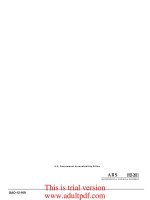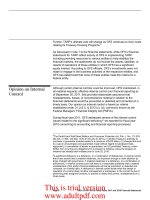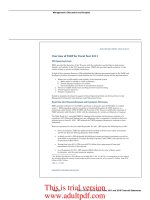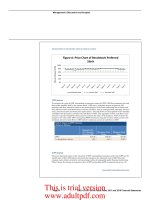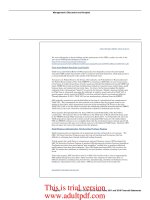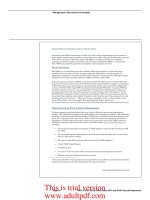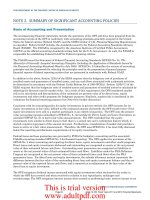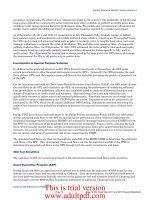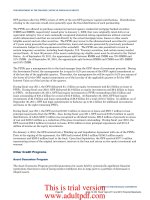United States Government Accountability Office GAO November 2011_part5 pptx
Bạn đang xem bản rút gọn của tài liệu. Xem và tải ngay bản đầy đủ của tài liệu tại đây (282.47 KB, 11 trang )
Management’s Discussion and Analysis
AGENCY FINANCIAL REPORT | FISCAL YEAR 2011
MANAGEMENT‘S DISCUSSION AND ANALYSIS
For more information on these holdings and the performance of the PPIFs, readers can refer to the
most recent PPIP Quarterly Report available at:
/>stability/programs/Credit%20Market%20Programs/ppip/Documents/PPIP%20Report%2009-2011.pdf
TTerm Asset-Backed Securities Loan Facility
TALF was a joint Federal Reserve-OFS program that was designed to restart the asset-backed
securities (ABS) market that provide credit to consumers and small businesses, which had ground to
a virtual standstill during the early months of the financial crisis.
Pursuant to its Federal Reserve Act Section 13(3) authority, the Federal Reserve Board authorized
the Federal Reserve Bank of New York (FRBNY) to extend up to $200 billion in non-recourse loans
to borrowers to enable the purchase of newly issued asset-backed (including newly issued CMBS and
legacy CMBS) AAA-rated securities including those backed by consumer loans, student loans, small
business loans, and commercial real estate loans. In return, the borrowers pledged the eligible
collateral with a risk premium (“haircut”) as security for the loans. Should a borrower default upon
its TALF loan or voluntarily surrender the collateral, it would be seized and sold to TALF LLC, a
special purpose vehicle created by FRBNY to purchase and hold seized or surrendered collateral.
Through September 30, 2011, TALF LLC has not purchased any collateral from the FRBNY.
OFS originally committed to provide $20 billion in the form of a subordinated loan commitment to
TALF LLC. This commitment was later reduced to $4.3 billion after the program closed to new
lending in June 2010, which represented 10 percent of the outstanding TALF loans at the time.
TALF LLC is able to use the funds to purchase the underlying collateral associated with the FRBNY
TALF loans in the event a borrower surrendered the collateral or defaulted upon its loan.
From inception through September 30, 2011, OFS has loaned $100 million of the $4.3 billion
commitment. The maturity date on the OFS loan to the TALF LLC is March 2019 with loans made
by the FRBNY through TALF maturing at the latest by March 2015. As of September 30, 2011, the
TALF program has experienced no losses and all outstanding TALF loans are well collateralized.
OFS and FRBNY continue to see it as highly likely that the accumulated excess interest spread will
cover any loan losses that may occur without recourse to the dedicated TARP funds. Therefore, OFS
does not expect any cost to the taxpayers from this program.
Small Business Administration 7(a) Securities Purchase Program
Small businesses play an important role in generating new jobs and growth in our economy. The
SBA’s 7(a) Loan Guarantee Program assists start-up and existing small businesses that face
difficulty in obtaining loans through traditional lending channels.
T
o help
ensure that credit flows to entrepreneurs and small business owners, OFS developed the
SBA 7(a) Securities Purchase Program to purchase SBA-guaranteed securities from pool assemblers.
Purchasing securities from participating “pool assemblers” enabled them to purchase additional
small business loans from loan originators. Since OFS began purchasing SBA 7(a) securities, the
SBA 7(a) market has stabilized, as exhibited by new pool issuance volumes returning to pre-crisis
levels.
Under this program, OFS invested in total in 31 SBA 7(a) securities with a value of approximately
$368 million during fiscal year 2010. Those securities were comprised of 1,001 loans from 17
different industries, including retail, food services, manufacturing, scientific and technical services,
healthcare, educational services, and others. OFS has now sold a total of 16 securities for
Page 42 GAO-12-169
OFS's Fiscal Years 2011 and 2010
Financial Statements
This is trial version
www.adultpdf.com
Management’s Discussion and Analysis
THE DEPARTMENT OF THE TREASURY | OFFICE OF FINANCIAL STABILITY
MANAGEMENT‘S DISCUSSION AND ANALYSIS
approximately $213.2 million. OFS continues to hold 15 SBA 7(a) securities with a gross
outstanding balance as of September 30, 2011, of approximately $127.6 million.
Other Programs
Automotive Industry Financing Program
The Automotive Industry Financing Program (AIFP) was begun in December 2008 to help prevent a
significant disruption of the U.S. automotive industry, because the potential for such a disruption
posed a systemic risk to financial market stability and would have had a negative effect on the
economy.
Recognizing both General Motors Corporation (Old GM) and Chrysler Holdings LLC (Old Chrysler)
were on the verge of potentially disorderly liquidations, OFS extended temporary loans to GM and
Chrysler in December 2008. After the Obama Administration took office, it agreed to provide
additional investments conditioned on each company and its stakeholders participating in a
fundamental restructuring. Sacrifices were made by unions, dealers, creditors and other
stakeholders, and the restructurings were achieved through bankruptcy court proceedings in a
record time. As a result, General Motors Company (New GM) and Chrysler Group LLC (New
Chrysler) are more competitive and viable companies, supporting American jobs and the economy.
Operating results have improved, the industry has added jobs and the TARP investments have
begun to be repaid.
Today, both companies have rebounded significantly. New GM’s second quarter 2011 profit was its
sixth consecutive profitable quarter. Since emerging from bankruptcy, New GM has added shifts at
six of its plants to address growing demand. A similar story is playing out at New Chrysler as the
company has lowered its structural costs, become more efficient, adopted new technologies,
rejuvenated its product line, and rebuilt its brand value. Today, its market share continues to
recover.
In total, OFS provided approximately $80 billion in loans and equity investments to GM, GMAC
(now known as Ally Financial), Chrysler, and Chrysler Financial. Please see Footnote 6 of financial
statements for further information on the AIFP subsidy cost.
General Motors
OFS provided $50 billion under TARP to Old GM, beginning with a $13.4 billion loan in December
2008 to Old GM to fund working capital. Under the loan agreement, Old GM was required to submit
a viable restructuring plan. The first plan Old GM submitted failed to establish a credible path to
viability, and the deadline was extended to June 2009 for Old GM to develop an amended plan. OFS
loaned an additional $6 billion to fund Old GM as it worked to submit a viable restructuring plan.
To achieve an orderly restructuring, Old GM filed for bankruptcy on June 1, 2009. OFS provided
$30.1 billion under a debtor-in-possession financing agreement to assist Old GM during the
restructuring. A newly formed entity, New GM purchased most of the assets of Old GM under a sale
pursuant to Section 363 of the bankruptcy code (363 Sale). When the sale to New GM was completed
on July 10, 2009, OFS converted most of its loans to 60.8 percent of the common equity in the New
GM and $2.1 billion in preferred stock. At that time, OFS held $6.7 billion in outstanding loans
which were repaid in full during fiscal year 2010. Approximately $986 million remained with Old
GM (now known as Motors Liquidation Company) for wind-down costs associated with its
liquidation.
Following the July 2009 restructuring and also as of September 30, 2010, New GM had the following
ownership: OFS (60.8 percent), GM Voluntary Employee Benefit Association (VEBA) (17.5 percent),
the Canadian Government (11.7 percent), and Old GM’s unsecured bondholders (10 percent). As
Page 43 GAO-12-169
OFS's Fiscal Years 2011 and 2010
Financial Statements
This is trial version
www.adultpdf.com
Management’s Discussion and Analysis
AGENCY FINANCIAL REPORT | FISCAL YEAR 2011
MANAGEMENT‘S DISCUSSION AND ANALYSIS
part of the restructuring, New GM issued warrants to acquire additional shares of common stock to
VEBA and Old GM (for distribution to the creditors of Old GM following confirmation of a plan of
liquidation by the bankruptcy court).
Several milestones were reached regarding OFS’ investment in New GM during fiscal year 2011.
x In October 2010, OFS accepted an offer from New GM to repurchase $2.1 billion of the TARP
preferred stock, conditioned on the closing of the proposed initial public offering of New GM’s
common stock. Under the agreement, New GM would purchase the preferred stock at a price
per share of $25.50, which was equal to 102 percent of the liquidation preference. In
December 2010, as announced in October 2010, New GM completed the repurchase of all
New GM preferred stock held by OFS for total proceeds of $2.14 billion.
x In November 2010, New GM completed its initial public offering (IPO) with net proceeds to
OFS of $13.5 billion. The price per share was $32.7525, which represents the public sale
price of $33 less underwriting discounts and fees, with the sale resulting in net proceeds less
than cost of $4.4 billion. The IPO reduced OFS’ ownership of New GM’s outstanding common
stock by nearly half from 60.8 percent to 32 percent.
x In March 2011, the Plan of Liquidation for Old GM became effective and OFS’ $986 million
loan to Old GM was converted to an administrative claim. OFS retained the right to recover
additional proceeds; however, any additional recovery is dependent on actual liquidation
proceeds and pending litigation. During fiscal year 2011, OFS received payments totaling
$111 million from Motors Liquidation Company.
CChrysler
In January 2009, OFS loaned $4 billion to Old Chrysler. Under the loan agreement, Old Chrysler
was required to implement a viable restructuring plan. In March 2009, the Administration
determined that the business plan submitted by Old Chrysler failed to demonstrate viability and
concluded that Old Chrysler was not viable as a stand-alone company. In fiscal year 2010, Old
Chrysler repaid $1.9 billion while $500 million was assumed by New Chrysler (see below). OFS
wrote off the remaining $1.6 billion of this loan.
The Administration subsequently laid out a framework for Old Chrysler to achieve viability by
partnering with the international car company Fiat. As part of the planned restructuring, in April
2009, Old Chrysler filed for bankruptcy protection. In May 2009, OFS provided $1.9 billion to Old
Chrysler under a debtor-in-possession (DIP) financing agreement for assistance during its
bankruptcy proceeding. The DIP loan was extinguished by the bankruptcy court in April 2010,
including collateral security attached to the loan, and transferred to a liquidation trust. OFS
retained the right to recover the proceeds from the liquidation of the specified collateral and received
$40.2 million from the liquidation trust in fiscal year 2010 and $7.8 million in fiscal year 2011.
In June 2009, a newly formed entity, Chrysler Group LLC, (New Chrysler) purchased most of the
assets of Old Chrysler under a 363 sale. OFS provided a $6.6 billion loan commitment to New
Chrysler (as of September 30, 2010, $2.1 billion remained undrawn), and received a 9.9 percent
equity ownership in New Chrysler. The agreement included the ability of Fiat to meet specific
performance related milestones which would increase the ownership percentage of Fiat and lower
the ownership percentage of OFS. In January, April and May 2011, Fiat met those performance
milestones, lowering the OFS ownership percentage to 6.6 percent (6.0 percent on a fully diluted
basis).
Page 44 GAO-12-169
OFS's Fiscal Years 2011 and 2010
Financial Statements
This is trial version
www.adultpdf.com
Management’s Discussion and Analysis
THE DEPARTMENT OF THE TREASURY | OFFICE OF FINANCIAL STABILITY
MANAGEMENT‘S DISCUSSION AND ANALYSIS
x In May 2011, New Chrysler repaid $5.1 billion in TARP loans and terminated its ability to
draw a remaining $2.1 billion TARP loan commitment. Of the repayment, $500 million was
to partially repay the January 2009 loan of $4 billion. New Chrysler’s repayment came six
years before the scheduled maturity of those loans in 2017.
x In July 2011, OFS received $560 million in proceeds from the sale of its remaining stake in
New Chrysler to Fiat. With the closing of this transaction, OFS has fully exited its
investment in New Chrysler. Fiat paid $500 million to OFS for its 98,461 shares or 6 percent
fully diluted equity interest in New Chrysler. Fiat also paid $60 million to OFS for its rights
under an agreement with the UAW retirement trust pertaining to the trust's shares in New
Chrysler.
From inception through September 30, 2011, OFS has received more than $11.1 billion of the $12.4
billion disbursed to Chrysler related entities (primarily Old Chrysler and New Chrysler) through
principal repayments, sale of stock, interest, and other collections. While OFS still holds an interest
in a liquidation trust, no significant future recoveries are expected. Accordingly, OFS is unlikely to
fully recover the difference of $1.3 billion.
Ally Financial (formerly GMAC)
In December 2008, OFS made an initial investment of $5 billion in GMAC. OFS also lent $884
million of TARP funds to Old GM (one of GMAC’s owners) for the purchase of additional ownership
interests in a rights offering by GMAC. In May 2009, federal banking regulators required GMAC to
raise additional capital by November 2009 in connection with the Supervisory Capital Assistance
Program (SCAP)/stress test. Also in May 2009, OFS exercised its option to exchange the loan with
Old GM for 35.4 percent of common membership interests in GMAC. OFS also purchased $7.5
billion of convertible preferred shares from GMAC in May 2009, which enabled GMAC to partially
meet the Supervisory Capital Assessment Program (SCAP) requirements. In December 2009, OFS
made additional investments of $3.8 billion in GMAC to enable GMAC to satisfy the SCAP
requirements and exchanged certain preferred shares for common stock. OFS provided the $3.8
billion in new capital in the form of $2.54 billion of Trust Preferred Securities (TruPS), which are
senior to all other capital securities of the company, and $1.25 billion of Mandatory Convertible
Preferred Stock.
In May 2010, GMAC changed its corporate name to Ally Financial, Inc. In December 2010, OFS
converted additional preferred stock in Ally Financial with a liquidation preference of $5.5 billion
into common stock – a move designed to accelerate OFS’ ability to exit its investment in the
company. The conversion increased OFS’ common equity stake in Ally Financial from 56 percent to
74 percent of total common shares outstanding. In connection with this conversion, OFS converted
its preferred stock at 1.0 times the book value of tangible common equity balance as of September 30,
2010, subject to certain adjustments. Ally Financial also agreed to assist OFS in the sale or sales of
its holdings of TruPS on terms acceptable to OFS and Ally Financial as soon as practical subject to
certain conditions.
In March 2011, OFS priced a secondary offering at par for all of its Ally Financial trust preferred
securities. Aggregate proceeds from the offering (together with a distribution fee) totaled
approximately $2.7 billion. With the proceeds from this sale, OFS has received approximately $5.1
billion from Ally Financial from inception of the program through September 30, 2011, including
$2.4 billion in dividends and interest. As of September 30, 2011, OFS holds $5.9 billion of
convertible preferred stock and 74 percent of the outstanding shares of common stock in Ally
Financial as discussed in footnote 6 to the OFS Financial Statements.
Page 45 GAO-12-169
OFS's Fiscal Years 2011 and 2010
Financial Statements
This is trial version
www.adultpdf.com
Management’s Discussion and Analysis
AGENCY FINANCIAL REPORT | FISCAL YEAR 2011
MANAGEMENT‘S DISCUSSION AND ANALYSIS
AAmerican International Group, Inc. (AIG) Investment Program
In September 2008, AIG was the largest provider of conventional insurance in the world, with
approximately 75 million individual and corporate customers in over 130 countries. AIG’s assets
exceeded $1 trillion and insured 180,000 businesses and other entities employing over 100 million
people in the U.S. It was a large issuer of commercial paper and the second largest holder of U.S.
municipal bonds.
Then, the financial crisis hit in October of 2008. AIG’s parent holding company engaged in financial
activities that were well beyond the business of life insurance and property and casualty insurance.
Its financial products unit was a significant participant in some of the newest, riskiest, and most
complex transactions of the U.S. financial system. In the chaotic environment of September 2008,
the Federal Reserve and Treasury concluded that AIG’s failure could be catastrophic. Among other
things, if AIG had failed, the crisis would have almost certainly spread to the entire insurance
industry, and its failure could have directly affected the savings of millions of Americans. Therefore,
the federal government took action to protect the U.S. financial system.
During September, October, and November 2008, the Federal Reserve and OFS took a series of steps
to prevent AIG’s disorderly failure and mitigate systemic risks. The initial assistance to AIG was
provided by the FRBNY before the passage of EESA and the creation of TARP. After EESA was
enacted, the OFS and the Federal Reserve continued to work together to address the challenges
posed by AIG.
In November 2008, OFS invested $40 billion in senior preferred stock of AIG and it also received
warrants to purchase common shares in the firm. The funds were used immediately to reduce the
loans provided to AIG by the FRBNY. The preferred stock was subsequently exchanged in April
2009, for face value plus accrued dividends, into $41.6 billion of a different series of preferred stock.
Complete details on the AIG investment are available in at the TARP Three Year Anniversary
Report and the TARP Two-Year Retrospective Report which are both available at:
/>room/reports/agency_reports/Pages/default.aspx.
AIG is now experiencing a turnaround. The company has completed a successful restructuring.
Having stabilized its operations, AIG is now in a stronger position to repay the OFS’ investments.
As a result, during fiscal year 2011, substantial progress has been made in reducing OFS’ exposure
to AIG.
x In January 2011, Treasury, FRBNY, the trustees of the AIG Credit Facility Trust (the
Trust)
8
8
The independent trust established to manage the Department of Treasury’s beneficial interest in Series C
preferred AIG shares.
and AIG completed the Restructuring previously announced on September 30, 2010.
This series of integrated transactions and certain corporate actions was designed to
accelerate the repayment of U.S. taxpayer funds and to promote AIG’s transition from a
majority government owned and supported entity to a financially sound and independent
entity. As part of the AIG restructuring on January 14, 2011, AIG drew $20.3 billion from
the capital facility made available by OFS, for a total of $27.8 billion drawn. In the
Restructuring, AIG repaid FRBNY a total of $47 billion. AIG no longer has any outstanding
obligations to the FBRNY (although the FRBNY has loans to two special purpose vehicles
which acquired assets from AIG). Following the Restructuring, OFS’ total investment in AIG
was $68 billion, and as of January 31, 2011, Treasury’s investment consisted of
approximately 1.655 billion shares of AIG common stock (1.092 billion shares owned by OFS
Page 46 GAO-12-169
OFS's Fiscal Years 2011 and 2010
Financial Statements
This is trial version
www.adultpdf.com
Management’s Discussion and Analysis
THE DEPARTMENT OF THE TREASURY | OFFICE OF FINANCIAL STABILITY
MANAGEMENT‘S DISCUSSION AND ANALYSIS
and 562.9 million shares owned by the Department, which were received on the termination
of the Trust), representing ownership of 92 percent of the company (77 percent held by OFS
and 15 percent held by the Treasury outside of OFS) as well as $20.3 billion of Treasury OFS’
preferred equity interests in two AIG owned Special Purpose Vehicles (SPVs). The SPVs are
wholly owned by AIG and consolidated on the AIG financial statements. The OFS owned 100
percent of the preferred share interest in the two SPVs. Generally, the SPVs pay the
Preferred Interest holder (i.e., OFS) a return of 5 percent per annum.
x Assets of the SPV’s included AIG equity interests in AIA, MetLife, AIG Star Life Insurance,
AIG Edison Life Insurance, Nan Shan Life Insurance, ILFC (Aircraft Leasing entity) and
Maiden Lane II and III. AIG is to repay the SPV preferred interest owned by OFS from
monetization of the non-cash assets of the SPVs.
x In February 2011, AIG sold its subsidiaries, AIG Star Life Insurance Co., Ltd. and AIG
Edison Life Insurance Company and repaid $2.1 billion to OFS, which reduced the total
outstanding amount of Treasury- OFS’ preferred equity interest in the SPVs from $20.3
billion to $18.2 billion.
x In March 2011, AIG repaid OFS $6.9 billion, which further reduced the total outstanding
amount of OFS’ preferred equity interests in the SPVs from $18.2 billion to $11.3 billion.
x In May 2011, Treasury completed the sale of 200 million shares of AIG common stock at
$29.00 per share for $5.8 billion, with $3.8 billion in proceeds to OFS, resulting in proceeds
less than cost of about $1.9 billion.
9
x In August 2011, AIG repaid OFS $2.2 billion, including $0.2 billion in preferred interest
returns recognized as dividends, which further reduced OFS’ preferred equity interest in the
SPVs from $11.3 billion to $9.3 billion. This repayment was funded through proceeds from
the sale of AIG’s Nan Shan Life Insurance subsidiary.
As of September 30, 2011, OFS’ remaining gross outstanding TARP AIG related investments
amounted to $51.1 billion, which consists of 960 million shares of AIG common stock
10
(with a cost
basis of $43.53 per share and a market value of $21.1 billion or $21.95 per share), and approximately
$9.3 billion of preferred equity interests. As of September 30, 2011, the aggregate value of the
holdings of the SPV greatly exceeds OFS’ preferred interests. Therefore, OFS does not currently
anticipate incurring any loss from its SPV preferred interests. Additional discussion of the AIG
investment including subsidy cost can be found in footnote 6 of the OFS Financial Statements.
OOPERATIONAL GOAL TWO: PREVENT AVOIDABLE FORECLOSURES AND PRESERVE
HOMEOWNERSHIP
OFS established several programs under TARP to combat the historic housing crisis and important
new reforms are being introduced in part because of TARP’s housing programs. While the housing
market remains depressed, TARP’s initiatives to assist struggling homeowners have helped provide
9
The sale consisted of 131,981,246 TARP shares and 68,018,754 non-TARP shares based upon the Treasury’s
pro-rata holding of those shares. The non-TARP shares are those received from the trust established by the
FRBNY for the benefit of the U.S. government. Proceeds for non-TARP common stock totaled $1.97 billion and
are not reported in OFS receipts.
10
OFS’ 960 million shares of AIG common stock represent 50.8 percent of AIG’s total shares outstanding as of
September 30, 2011. Treasury, outside of TARP, owns an additional 495 million shares of AIG common stock
which represent an additional 26.1 percent of AIG’s total shares on a fully diluted basis.
Page 47 GAO-12-169
OFS's Fiscal Years 2011 and 2010
Financial Statements
This is trial version
www.adultpdf.com
Management’s Discussion and Analysis
AGENCY FINANCIAL REPORT | FISCAL YEAR 2011
MANAGEMENT‘S DISCUSSION AND ANALYSIS
more affordable permanent monthly mortgage payments to over 850,000 homeowners and provided
an additional 18,000 homeowners (95 percent of these homeowners helped through non-GSE
programs) with alternative solutions to foreclosure. In addition, TARP’s housing programs have set
new standard practices for mortgage providers that have indirectly helped millions more.
Examples include:
x Establishing a single point of contact for homeowners seeking assistance. This critical
reform is helping to prevent homeowners from receiving conflicting information about their
options, while providing them access to a single, knowledgeable case manager who can guide
them through the modification process.
x Limiting the practice of “dual tracking” – where service providers begin the foreclosure
process while simultaneously evaluating homeowners for a modification.
x Requiring servicers to provide qualified unemployed homeowners with a forbearance period
during which their monthly payments are temporarily reduced while they look for a new job.
x Assessing servicers to ensure that they are complying with OFS’ housing program guidelines
and are meeting their obligations to homeowners fairly.
By introducing these and other new concepts, OFS’ housing programs are serving as a national
laboratory for helping the private and non-profit sectors address a foreclosure challenge on this
scale.
Using authority granted under EESA, OFS established housing programs under TARP that fall into
three initiatives: the MHA program, (which includes the HAMP), the Hardest Hit Fund (HHF) and
OFS’ support for the FHA Refinance Program. Together these programs make up a comprehensive
housing program, whose goal is to lower mortgage payments for at-risk borrowers, support loan
modifications aimed at providing sustainable, affordable mortgage payments for borrowers, prevent
avoidable foreclosures and provide incentives to investor/owners of loans, loan servicers, and
homeowners to participate in the program. To protect taxpayers, the MHA and HHF housing
initiatives generally have pay-for-success incentives: funds are spent only when transactions are
completed and thereafter only as long as those contracts remain in place. Therefore, funds will be
disbursed over many years.
Rather than try and stop every foreclosure, OFS’ housing programs have focused on assisting
families with home loans that would be sustainable over the long term if modified. For borrowers
whose mortgages could not be saved, OFS’s programs have helped them to make a more graceful and
orderly transition to a more sustainable living situation.
The total cost of the TARP housing programs, excluding administrative costs, cannot exceed—and
may be less than—$45.6 billion, which is the amount committed to that purpose.
HHome Affordable Modification Program (HAMP)
HAMP is a first lien mortgage modification program that provides incentives to mortgage servicers,
investors, and homeowners to reduce eligible homeowners’ monthly payments to affordable levels
based on the homeowner’s current income. Under this program, OFS pays the incentives for the
modification of loans not held by government sponsored enterprises (GSEs) while the GSEs bear the
cost of modifications of loans held by the GSEs. HAMP is the largest program within MHA and
includes several additional components to complement first lien modifications.
Page 48 GAO-12-169
OFS's Fiscal Years 2011 and 2010
Financial Statements
This is trial version
www.adultpdf.com
Management’s Discussion and Analysis
THE DEPARTMENT OF THE TREASURY | OFFICE OF FINANCIAL STABILITY
MANAGEMENT‘S DISCUSSION AND ANALYSIS
HAMP provides eligible homeowners the opportunity to reduce their monthly first lien mortgage
payments to 31 percent of their gross (pre-tax) income.
To qualify for HAMP, a borrower must:
x Own a one- to four-unit home that is a primary residence;
x Have received a mortgage on or before January 1, 2009;
x Have a mortgage payment (including principal, interest, taxes, insurance, and homeowners
association dues) that is more than 31 percent of the homeowner’s gross monthly income;
and
x Owe not more than $729,750 on a first mortgage for a one–unit property (there are higher
limits for two– to four– unit properties).
Before a mortgage can be permanently modified, the homeowner must make the new, reduced
monthly mortgage payment on time and in full during a trial period of three or four months.
Homeowners can earn up to $1,000 per year for five years to reduce the amount of principal they owe
up to $5,000 by making timely payments on permanently modified loans.
AAdditional Components of Making Home Affordable
x The FHA-HAMP Program provides the same incentives as HAMP for Federal Housing
Administration (FHA) guaranteed loans.
x The Second Lien Modification Program (2MP) provides incentives for second-lien holders to
modify or extinguish a second-lien mortgage when a modification has been initiated on the
first lien mortgage for the same property under HAMP.
x The Treasury/FHA Second Lien Program (2LP) provides incentives to servicers for
extinguishment of second liens for borrowers who refinance their first lien mortgages under
the FHA-Refinance Program.
x The Rural Development (RD)-HAMP Program provides incentives for modified United States
Department of Agriculture (USDA) guaranteed mortgages.
Housing Finance Agency Innovation Fund for the Hardest Hit Housing Markets (HFA Hardest Hit
Fund, or HHF)
In February 2010, the Obama Administration announced the HFA Innovation Fund for the Hardest
Hit Housing Markets (HFA Hardest Hit Fund, or HHF), which allow state HFAs in the nation’s
hardest hit housing markets and high unemployment markets to design innovative, locally targeted
foreclosure prevention programs. State HFAs design the state programs, tailoring the housing
assistance to their local needs. Further information on the funded programs is available at:
/>.
Support for the FHA-Refinance Program
In March 2010, the Administration announced enhancements to an existing FHA program that will
permit lenders to provide additional refinancing options to homeowners who owe more than their
homes are worth because of large declines in home prices in their local markets. This program,
Page 49 GAO-12-169
OFS's Fiscal Years 2011 and 2010
Financial Statements
This is trial version
www.adultpdf.com
Management’s Discussion and Analysis
AGENCY FINANCIAL REPORT | FISCAL YEAR 2011
MANAGEMENT‘S DISCUSSION AND ANALYSIS
known as the FHA- Refinance program, will provide more opportunities for qualifying mortgage
loans to be restructured and refinanced into FHA-insured loans.
Among other requirements:
x The homeowner must be current on the existing first lien mortgage;
x The homeowner must occupy the home as a primary residence and have a qualifying
credit score;
x The mortgage investor must reduce the amount owed on the original loan by at least ten
percent;
x The new FHA loan must have a balance less than the current value of the home; and
x Total mortgage debt for the borrower after the refinancing, including both the first lien
mortgage and any other junior liens, cannot be greater than 115 percent of the current
value of the home – giving homeowners a path to regain equity in their homes and an
affordable monthly payment.
TARP funds have been made available up to approximately $8 billion in the aggregate to provide
additional coverage to lenders for a share of potential losses on these loans and to provide incentives
to support the write-downs of second liens and encourage participation by servicers.
OFS has entered into a letter of credit (L/C) to fund the FHA- Refinance Program. Pursuant to this
L/C, a reserve account has been pre-funded with $50 million in funds for OFS’ share of any future
loss claim payments. OFS will be reimbursed for all unused amounts from this account. As of
September 30, 2011, no disbursements for loss claim payments under the FHA- Refinance Program
have been made.
MMHA Results
The incentives offered under MHA are helping homeowners and assisting in stabilizing the housing
market. Thro
ugh September 30, 2011, 112 active servicers have signed up for MHA. Between loans
covered by these servicers and loans owned or guaranteed by the GSEs, more than 85 percent of
first-lien residential mortgage loans in the country are now held by servicers participating in the
program. Through September 30, 2011, OFS has made commitments to fund up to $29.9 billion in
MHA payments.
After 31 months, more than 1.7 million homeowners participating in the OFS and GSE HAMP
programs have entered into trial modifications that reduced their mortgage payments to more
affordable levels. Of these homeowners, the OFS HAMP program has helped almost 800,000
participants. Over 850,000 homeowners participating in the HAMP programs have had their
mortgage terms modified permanently, with over 400,000 of those participants from the OFS HAMP
program. Homeowners participating in both the GSE and OFS HAMP programs collectively have
experienced a 37 percent median reduction in their mortgage payments—more than $525 per month.
MHA has also spurred the mortgage industry to adopt similar programs that have helped millions
more at no cost to the taxpayer.
OFS now publishes quarterly assessments of servicer performance, which contain data on
compliance with program guidelines as well as program results metrics. Going forward, OFS hopes
these assessments will set the standard for transparency about mortgage servicer efforts to assist
homeowners and encourage servicers to correct identified instances of noncompliance. For the second
quarter of calendar year 2011, two servicers had been determined to need substantial improvement.
Page 50 GAO-12-169
OFS's Fiscal Years 2011 and 2010
Financial Statements
This is trial version
www.adultpdf.com
Management’s Discussion and Analysis
THE DEPARTMENT OF THE TREASURY | OFFICE OF FINANCIAL STABILITY
MANAGEMENT‘S DISCUSSION AND ANALYSIS
These servicers were also in need of substantial improvement in the first quarter, and their servicer
incentives have been withheld since June 1, 2011.
MHA performance highlights for fiscal year 2011 can be found at:
/>.
Hardest Hit Fund Results
The Hardest Hit Fund provides funding to 18 states and the District of Columbia (DC) to provide
assistance to struggling homeowners through locally-tailored programs administered by each
respective HFA. $7.6 billion has been allocated of the $45.6 billion committed for the housing
programs. From inception of the program through September 30, 2011, a total of $655 million has
been drawn down from OFS by the 18 states and DC. Each state has its own timeline for
implementation of their programs and draws down funds as they are needed.
HHousing Scorecard
The U.S. Department of Housing and Urban Development (HUD) and OFS also release a Monthly
Housi
ng Scorecard on the nation’s housing market. Each month the scorecard presents key housing
market indicators and highlights the impact of the Administration’s housing recovery efforts,
including assistance to homeowners through the FHA and the HAMP. The Housing Scorecard is
available at:
www.hud.gov/scorecard
.
OPERATIONAL GOAL THREE: PROTECT TAXPAYERS’ INTERESTS
OFS manages TARP investments to minimize costs to taxpayers and receives income on its holdings
of preferred equity and other TARP investments in the form of interest, dividends and fees. OFS
also takes steps to ensure that TARP recipients comply with any TARP-related statutory or
contractual obligations such as executive compensation requirements and restrictions on dividend
payments.
Consistent with the statutory requirements, OFS’ four overarching portfolio management guiding
principles are as follows:
x Protect taxpayer investments and maximize overall investment returns within competing
constraints,
x Promote stability for and prevent disruption of financial markets and the economy,
x Bolster market confidence to increase private capital investment, and
x Dispose of investments as soon as practicable, in a timely and orderly manner that
minimizes financial market and economic impact.
OFS’ asset management approach protects taxpayer investments and promotes stability through
evaluating systemic and individual risk from standardized reporting, proactive monitoring and
ensuring adherence to EESA and compliance with contractual agreements. By avoiding involvement
in day to day company management decisions and exercising its rights as a common shareholder
only on core governance issues, OFS seeks to bolster market confidence to increase private capital
investment.
OFS seeks to exit investments as soon as practicable to remove OFS as a shareholder, eliminate or
reduce OFS exposure, return TARP funds to reduce the federal debt, and encourage private capital
formation to replace federal government investment. The desire to achieve such objectives must be
balanced against a variety of other objectives, including maximizing taxpayer returns, avoiding
further financial market and/or economic disruption, and the potentially negative impact to the
Page 51 GAO-12-169
OFS's Fiscal Years 2011 and 2010
Financial Statements
This is trial version
www.adultpdf.com
Management’s Discussion and Analysis
AGENCY FINANCIAL REPORT | FISCAL YEAR 2011
MANAGEMENT‘S DISCUSSION AND ANALYSIS
issuer’s health and/or capital raising plans from OFS’ disposition. An issuer typically needs the
approval of its primary federal regulator in order to repay OFS and therefore regulatory approvals
also affect how quickly an institution can repay.
In managing the TARP investments, OFS takes a disciplined portfolio approach with a review down
to the individual investment level. OFS aims to monitor risk and performance at both the overall
portfolio level and the individual investment level. Given the nature and size of the portfolio, risk
and performance are linked to the overall U.S. financial system and the economy. In conducting the
portfolio management activities, OFS employs a mix of dedicated professionals and external asset
managers. These external asset managers provide market specific information such as market
prices and valuations as well as detailed credit analysis using public information on a periodic basis.
Risk
Assessment
OFS has developed procedures to identify and mitigate investment risk. These procedures are
design
ed to identify TARP recipients that are in a significantly challenged financial condition to
ensure heightened monitoring and additional diligence and to determine appropriate responses by
OFS to preserve the taxpayers’ investment and minimize loss as well as to maintain financial
stability. Specifically, OFS’ external asset managers review publicly available information to identify
recipients for which pre-tax, pre-provision earnings and capital may be insufficient to offset future
losses and maintain required capital. For certain institutions, OFS and its external asset managers
engage in heightened monitoring and due diligence that reflects the severity and timing of the
challenges.
Although OFS relied on the recommendations of federal banking regulators in connection with
reviewing and approving applications for assistance, OFS generally does not have access to non-
public information collected by federal banking regulators on the financial condition of TARP
recipients. To the contrary, there is a separation between the responsibilities of OFS as an investor
and the duties of the federal government as regulator.
The data gathered through this process is used by OFS in consultation with its external managers
and legal advisors to determine a proper course of action. This may include making
recommendations to management or working with management and other security holders to
improve the financial condition of the company, including through recapitalizations or other
restructurings. These actions are similar to those taken by large private investors in dealing with
troubled investments. OFS does not seek to influence the management of TARP recipients for non-
financial purposes.
Compliance
OFS also takes steps to ensure that TARP recipients comply with their TARP-related statutory and
contractua
l obligations. Statutory obligations include executive compensation restrictions.
Contractual obligations vary by investment type. For most of OFS’ preferred stock investments,
TARP recipients must comply with restrictions on payment of dividends and on repurchases of junior
securities, so that funds are not distributed to junior security holders prior to repayment of the
federal government. Recipients of exceptional assistance (currently AIG, GM, and Ally) must comply
with additional restrictions on executive compensation, lobbying, corporate expenses and internal
controls and must provide quarterly compliance reports.
All servicers voluntarily participating in MHA have contractually agreed to follow the MHA program
guidelines, which require the servicer to offer a MHA modification to all eligible borrowers and to
have systems that can process all MHA-eligible loans. Servicers are subject to periodic, on-site
compliance reviews performed by OFS’ compliance agent, Making Home Affordable-Compliance
(MHA-C), a separate, independent division of Freddie Mac, to ensure that servicers satisfy their
Page 52 GAO-12-169
OFS's Fiscal Years 2011 and 2010
Financial Statements
This is trial version
www.adultpdf.com
